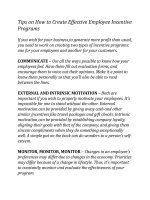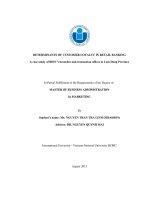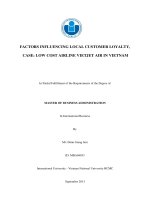Expanding personalization to build customer loyalty
Bạn đang xem bản rút gọn của tài liệu. Xem và tải ngay bản đầy đủ của tài liệu tại đây (2.64 MB, 7 trang )
Expanding personalisation to rebuild customer loyalty
To gain greater insight into changes and innovations that could usher in
a new era for travellers, the Economist Intelligence Unit (EIU) conducted
parallel surveys of 100 airline executives and 810 air-travel customers in
August and September of 2013. Augmented by interviews with 16 industry
leaders and in-depth analysis, research into this topic culminated with the
whitepaper, The Future of Air Travel: Improved Personalisation and Profits
through the Integrated Use of Customer Data. This is one of a series of five
articles elaborating on some of the most salient points that emerged from
the findings.
Airlines are now able to provide more individualised
attention to a broader range of customers than ever before. That’s because the amount of information that can
be quickly collected, transmitted, analysed and stored is
increasing, while the associated costs have been reduced
in the wake of advances in digital technologies.
Architect Tim Kobe was a key player in bringing Apple stores to fruition and has applied this approach to
airlines. His firm, Eight Inc., designed the Virgin Atlantic
Airways Clubhouse at San Francisco International Airport. Like other lounges, it provides a place to rest, work,
meet and eat, but it does so in a unique space — one
designed to facilitate more personal experiences.
Airlines that take advantage of data, customer analytics
and mobile digital devices to maintain efficiency and
deliver a more personalised, fine-tuned experience are
poised to enjoy a distinct advantage over those offering
a more generic service. Airlines can learn from trailblazers in the retailing and hospitality industries that have
invested in data-related technologies and techniques to
better understand and support their customers, helping
maintain customer loyalty, while positioning themselves
as end-to-end service providers.
Personalisation was a key design consideration, according to Mr Kobe, grounded in a keen understanding of the
needs and desires of Virgin Atlantic’s business and leisure
travel customers. The lounge feels more like a boutique
hotel than a generic airport space. Section-to-section differentiation is sharp, from décor to materials to
furnishings to use of light, both natural and artificial. A
broad range of services are located in different zones for
different activities to accommodate personal styles and
preferences.
Personalising the experience
Leaders in the retail industry are marketing experiences
rather than products. Apple, for example, commands a
premium across its product line, from computing to communication to entertainment. Its prices are justified, in
part, by function and engineering quality, but also by the
personal connection that customers feel to their products
and the brand. Apple stores were specifically designed as
destinations — not as retail outlets — fun environments
where people would feel at home. (For more on lessons
from Apple, please see the affiliated article, “The future
of air travel: Justifying the return on investment (ROI) of
technology upgrades”).
2
EXPANDING PERSONALISATION TO REBUILD
CUSTOMER LOYALTY
Reading the data, reaping the revenue
For the business traveller, for example: working spaces
featuring “multi-tasking” armchairs like those found on
luxury airlines in which you are able to sit up and work
with support—or lie back and relax in comfort. Those
travelling for leisure will likely make their way to the
viewing area or bar or the dining section for a made-toorder meal. Virgin Atlantic’s even-larger London Clubhouse offers a den for billiards, video games or movie
watching, with lounging rooms designed to appeal to a
variety of tastes and aesthetic preferences—from aprèsski to poolside.
Airlines can take pointers from the hospitality industry,
which has learned to sculpt increasingly personalised experiences using ever-more-granular data about customer needs and desires. Higher-end hotels, for example,
often provide pillow menus. But, with the unbundling of
fares, many airlines have gone in the opposite direction:
only one kind of pillow is offered; should you want one,
there’s a cost involved.
Not only does the latter approach limit options instead
of expanding them, it also minimises opportunities to
gather data about those options from the customer.
So far, hotels are ahead of airlines in using this sort of
information to learn each customer’s preferences to
either proactively tailor guest experiences based on that
data or offer intelligent options based on customers’ past
behaviours.
When speaking about his work on Virgin’s San Francisco
Clubhouse, Mr Kobe explains that the goal was not to
create a lounge that was generically great, but to provide
a unique and “customisable” experience meant to be personally compelling to Virgin’s customer base.
“Our work with Virgin helped separate the brand in a
crowded field,” Mr Kobe says, creating “a distinct experience for Virgin customers . . . and a relatively loyal
[customer base] . . . who share the Virgin brand values.”
3
EXPANDING PERSONALISATION TO REBUILD
CUSTOMER LOYALTY
Appealing to a wave of new customers
While the Hotel Preston, in Nashville, Tennessee, offers
a choice of pillows, it also provides a menu of more
idiosyncratic options: lava lamps, a live goldfish in a bowl
and — for children of all ages — bathtub rubber duckies,
something that makes an indelible impression on the
hotel’s guests. A generic room is a commodity; a room
one can personalise with whimsy is an experience—one
that the hotel will be able to re-create whenever you visit without your having to ask.
“There’s an emerging Millennial trend,” says Max Rayner, a partner at travel and technology consulting firm
Hudson Crossing, of customers who are coming into
prime travelling age who “don’t want a chain or a package or two hundred other people getting the exact same
thing.” Netflix and Amazon have taught these consumers
to expect providers will learn their preferences and take
them into account.
Millennials as a group tend to insist on 24/7 access to
data, want to be able to change and re-configure plans
on the fly, and value unique, off-the-beaten-path experiences. Of course, on an individual basis within that group,
like any other, tastes and habits will vary. The hospitality
industry has shown it understands that the more options
it can draw into the mix, the better it will be able to target the right options to the right person.
Provenance Hotels — owner and operator of a dozen or
so properties, the Preston included — touts its ability to
“gracefully walk the high wire between seamless efficiency and palpable human connection”. Airlines would
do well to follow suit, especially given the rising tide
of more-demanding customers and the acknowledged
stress of airline travel.
4
EXPANDING PERSONALISATION TO REBUILD
CUSTOMER LOYALTY
Ensuring a sound technical foundation
Priceline, for instance, recently bought Buuteeq, a Software-as-a-Service website design and services provider
for smaller hotels that don’t yet have sophisticated digital
capabilities to reach online customers. Google Travel is
also trying to court this same target audience, enriching
search options to include smaller venues. They’re aiming,
says Mr Rayner, to provide ever-greater details on harder-to-find places, “showing you, for example, attractive,
five-room, Mom-and-Pop lodgings, in southern Spain”.
Strategic investments in information technology are a
crucial underpinning for personalisation. In his previous
position as chief technology officer of Travelzoo, Mr
Rayner was responsible for the user interface and the
back-end technology on which the site ran. Now, as a
partner at Hudson Crossing, a strategic advisory firm specialising in the travel, tourism and hospitality industries,
he stresses that airlines need a “holistic systems view” of
upgrades and all other upsell opportunities. The incremental revenue from selling more personalisation relies
on and is enabled by strategic investment in IT infrastructure, on both the operations and customer sides.
Airlines are also working to offer customers more
personalised options. Some, for example, are providing
activity packs or backpacks for children and families who
fly with them. And, while space limitations are a clear
constraint on what can be offered in the sky, technology
is expanding virtual space: re-creating how passengers work and play. Such options will become easier for
airlines to offer as in-flight bandwidth goes up and costs
come down.
Too many airlines, warns Mr Rayner, fail to see this. “All
those things that might look like they’re just a matter of
the user interface? They’re really not. You must have the
IT infrastructure to back it.” Delta got it right, he notes.
Its phone app and website are well-designed from both
the user perspective and the company’s — the IT systems
solidly integrated — offering multiple opportunities for trip
personalisation and revenue-producing upsells.
5
EXPANDING PERSONALISATION TO REBUILD
CUSTOMER LOYALTY
Clearly, these distinctions and lines of demarcation can
and will change over time. In the 1980s, some people
found answering machines uncomfortable and refused to
talk to them. Today, consumers converse with Siri, which
learns your voice, and take search advice from Google,
which gets to know your habits. While the mathematics
underlying all this technology may strike some as overly
analytical, it’s what will allow the airline industry — like
the hospitality and retail industries before it — to refine
the tools to help make the customer experience more
warmly and humanly personal.
Retailers have also been refining their systems integration online. A genuinely personalised experience requires
multiple data streams from different parts of a company
to be integrated and harmonised almost instantaneously.
When a customer begins to browse an online site, her
historical profile has to be matched with click-by-click
behaviour and locational information to extrapolate what
she might want and why she might want it. This kind
of data analysis and integration can lay the foundation
for travel providers to offer an equally bespoke level of
personalisation.
Does the technology know too much?
As advances in technology and data analytics allow service providers to move from data-based profiling to dayto-day reading of a specific traveller’s variable intent,
mood and state of mind, customers may find themselves
walking a difficult line: between wanting technology to
understand them, and therefore help them personalise
experiences in ways they will enjoy, and recoiling from
guesses so accurate that they might be experienced as
intrusive.
6
EXPANDING PERSONALISATION TO REBUILD
CUSTOMER LOYALTY
Worldwide Headquarters
Sabre Airline Solutions
3150 Sabre Drive
Southlake, Texas 76092 USA
Please contact our nearest
regional office for more information:
Europe, Middle East, Africa
Tel: +44 208 538 8539
Email:
The Americas
Tel: +1 682 605 6750
Email:
Asia Pacific
Tel: +65 6215 9500
Email:









